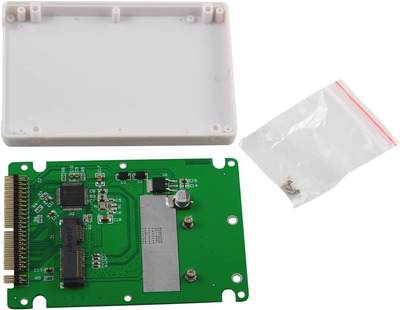BitWrangler wrote on 2023-07-07, 02:20:
What I understood to be the case is that very large majority of CF to IDE adapters available don't support 80 conductor AT66-133 cables, so fall back to ATA33. You can plug them in, but the connection doesn't make it past the PCB connector so they fail the test and default to 33.
You are correct. Here's an easy guide to determine if this an issue for you:
If your computer is slower than 600Mhz, this is probably not an issue for you, because your computer probably can't go faster than UDMA2.
If your CF adapter has a male 40 pin connector, you are fine as long as you attach the adapter with an 80 conductor cable.
If your CF adapter has a female 40 pin connector, you likely need to short pin 34 in order to get speeds faster than UDMA2 (ATA-33). You can also get a male to male cross over cable and attach your adapter to an 80 conductor cable.
In practice I found that while it is nice to be able to go faster than UDMA2, it wasn't that big of a deal for most CF devices. They just were not fast enough. I tested a group of 10 CF devices. Yes, all were slightly slower when using UDMA2 (ATA-33) vs faster transfer rates but there were was only 1 device that was able to go significantly faster than the UDMA limit of 33MB/s and it had a random access latency > 4.5 ms , which is undesirably high for solid state storage. Also it would not go faster than UDMA4 on a PC. I think that device had firmware optimized for for camera use cases, not PC applications.
Yes, I tricked out my CF adapters so that they allow speeds faster than UDMA2. Yes there was a difference that I could measure with synthetic benchmarks, but ... no, it wasn't a big real world difference. The CF devices I tested were either not fast enough to take advantage of the additional bandwidth provided by the faster transfer rates or had undesirably high random access times.
There is a high variance in CF performance. A really good CF might give you 0.27ms with 30MB/s . An average CF would be 0.45ms with 19MB/s. A crappy CF can give you >10ms access times w/ < 2MBs throughput. My best CF was from Topram. The worst might have been damaged or rebrand, since the other DaneElec devices performed pretty well. The Lexar and Transcend "UDMA7" devices I tested seemed to be optimized for cameras and had good throughput but higher latency
Sintechi SD bridges have relatively mild performance variations depending on the SD used. All the devices I tested were slower than the best CFs devices but better than the average CF devices. Sintechi devices are internally limited to "High Speed" SD transfer mode, which has been around for about 20 years, which is why all the SD cards I have performed in a fairly narrow range, with a small latency for throughput tradeoff, with the lowest latency being 0.35ms w/ 15MBs transfers while the highest throughput was 0.48ms & 20MBs transfers.
Hyperdisk 40 pin DOMs were competitive with the best CFs devices at capacities <= 4GB and devices > 4GB started to perform closer to the solid state sata solutions if I modded the device to allow speeds > UDMA2 (short pin 34 or use a male/male crossover cable)
Msata devices are significantly faster than all CF and SD solutions and buffered SSD devices faster still but it is unlikely that you will see that big of a difference between any of these storage solutions on computers that can't do UDMA2. Msata and SSD's start to separate from the pack at speeds faster than UDMA2
And in conclusion:
- CF devices often have good price / performance / capacity ratio storage needs < 16GB for controllers that don't go faster than UDMA2. Look for CF devices labeled "Industrial" instead of "UDMA7" because the ones labeled "UDMA7" usually have firmware optimized for camera work loads (high latency access to large files on a protocol that PC's don't support), while the ones labeled "Industrial" are intended for HD replacement (low latency r/w access to many small files).
- If your CF-IDE adapter has a female ATA connector, you likely won't go faster than UDMA2 without a hardware mod or crossover cable
- Hyperdisk DOMs are nice but also required a mod to go faster than UDMA2
- Sintechi SD bridges have a good price / performance / capacity ratio for controllers that don't go faster than UDMA2
- 32GB msata devices have the best price / performance / capacity for the 16GB to 32GB range for controllers that go faster than UDMA2. Sometimes the sata bridges in these devices or higher capacity of this storage is not ideal for devices slower than UDMA2.

